|
| |
|
Marvelous Superheroes
by Bob Brooke
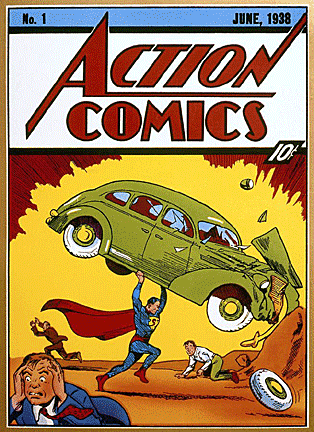 Blockbuster
movies featuring a spider man, a raging green hulk, a group of mutant
humans, and a man blinded by radioactive waste brought about a
resurgence in comic book collecting. And with The Hulk, X-Men,
Spiderman, and Wonderwoman bursting onto the big screen, there’s a
renewed interest in pulp fiction heroes. Blockbuster
movies featuring a spider man, a raging green hulk, a group of mutant
humans, and a man blinded by radioactive waste brought about a
resurgence in comic book collecting. And with The Hulk, X-Men,
Spiderman, and Wonderwoman bursting onto the big screen, there’s a
renewed interest in pulp fiction heroes.
The superhero movies are pretty faithful to their comic book roots.
American comic books trace their roots back to 1933 when a syndicated
newspaper published part of its Sunday comic's page on 7 by 9 inch
plates. Eastern Printing employees Max Gaines and Harry Wildenberg
believed two such plates could fit a tabloid-size page, producing a 7 by
10-inch book when folded. The two took newspaper strips and reprinted
them in a booklet titled Funnies On Parade, which Proctor & Gamble Co.
used as a premium.
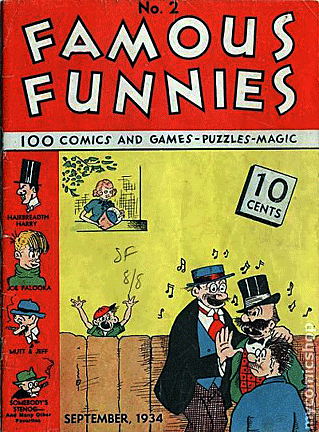 Gaines
convinced Eastern executives he could sell similar books to large
advertising firms. Eastern then produced and distributed Famous Funnies
and Century of Comics. Both were a resounding success. Gaines
convinced Eastern executives he could sell similar books to large
advertising firms. Eastern then produced and distributed Famous Funnies
and Century of Comics. Both were a resounding success.
Surprised with the popularity of the giveaway comics, Gaines believed
children would purchase the comic if it were reasonably priced. Eastern
printed Famous Funnies Series One to sell in retail stores for 10 cents.
It immediately sold out, becoming the first monthly comic and continued
in production until 1955.
Early comic books featured nothing more than reprinted material. In 1935
New Fun became the first comic to break the "reprinted material"
barrier, by featuring the antics of Oswald the Rabbit.
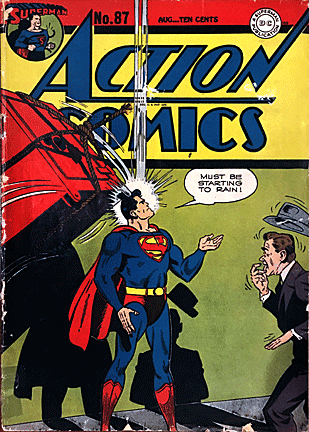 The
comic book industry took a gigantic leap forward in June 1938 when a man
in blue and red tights took the industry by storm. In 1938, the first
issue of Action Comics showcased the amazing feats of Superman. Just as
his flying abilities allowed him to leap tall buildings in a single
bound, this power also catapulted him to the top of the sales list. The
comic book industry took a gigantic leap forward in June 1938 when a man
in blue and red tights took the industry by storm. In 1938, the first
issue of Action Comics showcased the amazing feats of Superman. Just as
his flying abilities allowed him to leap tall buildings in a single
bound, this power also catapulted him to the top of the sales list.
Jerry Siegel and Joe Shuster created Superman in 1933. They tried to
market their character to every newspaper syndicate but all rejected
them. They waited five years to find a buyer and signed a contract with
Artist Bob Kane who modeled his creation on drawings of Leonardo da
Vinci's flying machines. Da Vinci even inspired Batman's name. He wrote,
“Remember that your bird should have no other model than the bat."
Although Batman had no superpowers, he appealed to young readers. He
wore a costume. He was smart. And he used an assortment of tech gadgets.
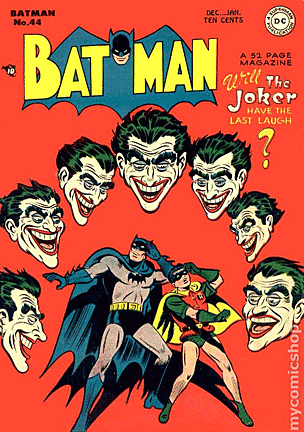 The
Spring of 1940 witnessed the birth of Batman with the publishing of
Batman No. 1. The Joker and Cat Woman also appeared for the first time
in the inaugural edition. The
Spring of 1940 witnessed the birth of Batman with the publishing of
Batman No. 1. The Joker and Cat Woman also appeared for the first time
in the inaugural edition.
Other main characters made their appearances in issues of Detective
Comics before crossing over to the Batman title. Robin, the Boy Wonder,
debuted in Detective Comics No. 38. The Penguin made his first
appearance in Detective Comics No. 58. And Robin made history in 1988
when fans voted to have him killed-off. Detective Comics later became
known as DC.
In the fall of 1939, Timely Comics published Marvel Comics No. 1. This
comic contained the first appearances of The Human Torch. Timely would
eventually become Marvel Comics, who along with DC dominated the comic
book publishing industry for years.
Captain America made his debut in March 1941. He appeared in his own
comic right from the start, something unheard of to this point.
Previously, all new characters appeared in another comic before being
granted their own title. This way, publishers could gauge reader
reaction via comic sales to see if the new character would be viable on
his own. Captain America began his career fighting Nazis months before
America declared war.
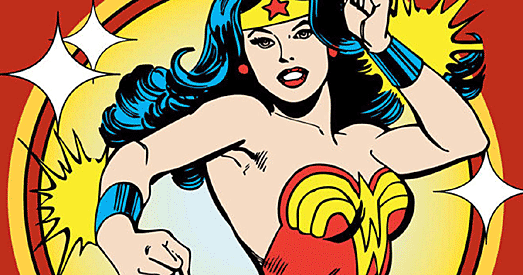
In the spring of 1941, Wonder Woman appeared on newsstands followed by
Captain Marvel and The Green Lantern. By the end of that year, over 150
different comic titles appeared on newstands.
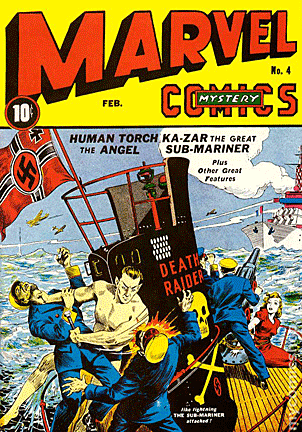 World
War II had a dramatic effect on the comic book industry. Dell published
the first war comic, appropriately titled War Comics No. 1. Many
super-heroes rushed into the armed forces to battle the enemy. Commando
Yank, Major Victory, Jungle Jim, Spy Smasher and The Unknown Soldier all
played hero to many teens on the home front. World
War II had a dramatic effect on the comic book industry. Dell published
the first war comic, appropriately titled War Comics No. 1. Many
super-heroes rushed into the armed forces to battle the enemy. Commando
Yank, Major Victory, Jungle Jim, Spy Smasher and The Unknown Soldier all
played hero to many teens on the home front.
The 1940s saw the creation of two teen idols. After debuting in Pep
Comics, Archie Andrews was given his own comic title in 1942. Archie
continues to draw a large following of teenage readers. Katy Keene made
her first appearance in Wilbur Comics in 1945. Following appearances in
three other comics, the beauty queen was given her own title in 1950.
With the end of World War II came the desire for change. Adventure
writers were having problems developing new plots, while humor writers
found it hard to be funny after a conflict that saw the loss of millions
of lives. With the industry unable to rejuvenate itself, publishers had
to create new titles, categories and formats.
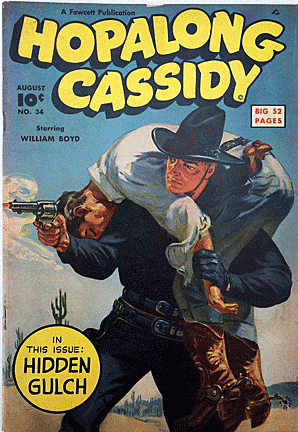 One
genre that found success at the end of the 1940s was the western comic.
In 1948 comic publisher Fawcett had a huge hit with its Hopalong Cassidy
title. Other publishers scrambled to take advantage of the new genre.
All American Western, Annie Oakley, and The Two-Gun Kid all rode onto
newsstands with the fury of a desperado cornered in a dead end canyon. One
genre that found success at the end of the 1940s was the western comic.
In 1948 comic publisher Fawcett had a huge hit with its Hopalong Cassidy
title. Other publishers scrambled to take advantage of the new genre.
All American Western, Annie Oakley, and The Two-Gun Kid all rode onto
newsstands with the fury of a desperado cornered in a dead end canyon.
With the down of the 1950s, comic book readership continued to decline.
Even Superman was faltered. But comic book publishers continued to press
on. In an attempt to regain customers, several publishers turned to
violence.
The Silver Age of comics began in 1956 with the publication of Showcase
No. 4 featuring the adventures of The Flash—the fastest man alive. This
character had the same name and same powers as his golden age
counterpart, but the stories were completely different.
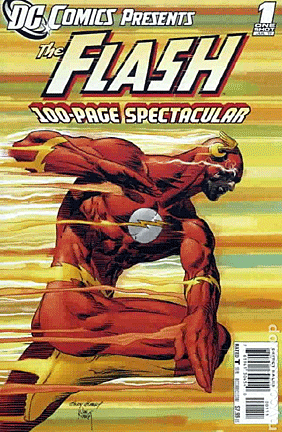 Marvel
comics introduced a superhero team in November 1961 with Fantastic Four
No. 1. The title's main characters obtained their super powers when
their spacecraft traveled though a cosmic storm. Marvel
comics introduced a superhero team in November 1961 with Fantastic Four
No. 1. The title's main characters obtained their super powers when
their spacecraft traveled though a cosmic storm.
The most recognized Marvel superhero first scurried across the pages of
Amazing Fantasy 15 in August 1962. Peter Parker, aka Spider-Man, was a
geeky high school student who attained the traits of an arachnid when a
radioactive spider bit him. In March 1963, Spider-Man received his own
title when The Amazing Spider-Man No. 1 came out.
Spider-Man has been the subject of several controversial stories. In the
early 1970s, a Spider-Alan story was published that showcased the
harmful effects of drugs. Two years later, The Amazing Spider-Man #121
shocked the comic world when Spiderman's girlfriend was murdered.
 Marvel's
next superhero was the result of exposure to radiation. The Incredible
Hulk No. 1 burst onto newsstands featuring the exploits of Dr. Bruce
Banner. Marvel's
next superhero was the result of exposure to radiation. The Incredible
Hulk No. 1 burst onto newsstands featuring the exploits of Dr. Bruce
Banner.
The 1970s arrived with the birth of Conan the Barbarian, The Swamp
Thing, and The Micronauts. Major publishers reprinted the most valuable
comic titles from the past. However, unscrupulous dealers stripped them
of their covers and sold them as originals.
With new titles being canceled as fast as they originated, publishers
were hard pressed to find original ideas that would captivate and hold
readers. Most collectors today search for certain writers and artists
and follow them as they move from title to title.
< Back to Collecting Archives
Next Article > |
|

|
|
FOLLOW MY WEEKLY BLOG
Antiques Q&A
JOIN MY COLLECTION
Antiques and More
on Facebook
LIKE MY FACEBOOK PAGE
The Antiques
Almanac on Facebook |
|
No antiques or collectibles
are sold on this site.
|
|
How to Recognize and
Refinish Antiques for Pleasure and Profit
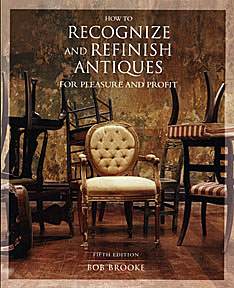
Have
you ever bought an antique or collectible that was less than perfect and
needed some TLC? Bob's new book offers tips and step-by- step
instructions for simple maintenance and restoration of common antiques.
Read an
Excerpt
|
|

|
|
|
|
|
